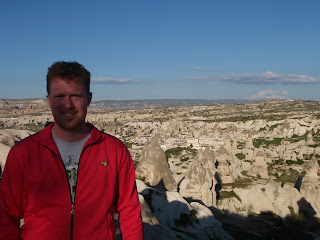The consequence of my spontaneous bus ride to Göreme, was that I had to find affordable accommodation by 22 clock. This was surprisingly easy. The reason for this is that Cappadocia, and especially Göreme is a center of tourism in Turkey.
The landscape and how people transformed it, is the reason for tourists to come to Cappadocia. For over two thousand years people live in caves, that were carved in strange volcanic rock formations.
Because of the variety of sites (at least two Unesco world heritage sites) in a radius of 100 miles and my tight schedule (two days) I booked a tour for the second day.
The first day I explored the surroundings on my own. After a short visit to the open-air museum of Göreme (world cultural heritage, early Christian cave churches, many bus tours), I wandered through the red and the rose valley to Ürgüp. After all the cities I have visited since the beginning of my trip, the empty valleys and spectacular scenic variety was more than welcome to me.
The next morning we went by minibus across Cappadocia. The tour was despite the usual problems (overpriced drinks at lunch and a product demonstration at the end) good. This was due to the imposing monuments, the aggressive driving style of the bus driver and not least to the guide. Most attractions were created from the plight of the early Christians emerged to hide from their enemies . Highlights of the tour were the underground city Derinkuyu and Ilhara valley. The underground city is a man-made tunnel and cave system that extends on multiple levels to a depth of 70 meters. There were 2,000 people using the shelter for up to four months. The tunnels are designed for people up to 1.70 meters. The Ilhara Valley is the deepest valley of Cappadocia and on this ground, the early Christians hid from their enemies. It is an idyllic valley with the characteristic Cappadocian caves carved in the sheer cliffs of the valley.
Fortunately, the tour ended in Goreme half an hour before my bus left for Antep.
If you travel to Cappadocia be advised to carry a flashlight, as some of the caves are very poorly lit or not at all.
The landscape and how people transformed it, is the reason for tourists to come to Cappadocia. For over two thousand years people live in caves, that were carved in strange volcanic rock formations.
Because of the variety of sites (at least two Unesco world heritage sites) in a radius of 100 miles and my tight schedule (two days) I booked a tour for the second day.
The first day I explored the surroundings on my own. After a short visit to the open-air museum of Göreme (world cultural heritage, early Christian cave churches, many bus tours), I wandered through the red and the rose valley to Ürgüp. After all the cities I have visited since the beginning of my trip, the empty valleys and spectacular scenic variety was more than welcome to me.
The next morning we went by minibus across Cappadocia. The tour was despite the usual problems (overpriced drinks at lunch and a product demonstration at the end) good. This was due to the imposing monuments, the aggressive driving style of the bus driver and not least to the guide. Most attractions were created from the plight of the early Christians emerged to hide from their enemies . Highlights of the tour were the underground city Derinkuyu and Ilhara valley. The underground city is a man-made tunnel and cave system that extends on multiple levels to a depth of 70 meters. There were 2,000 people using the shelter for up to four months. The tunnels are designed for people up to 1.70 meters. The Ilhara Valley is the deepest valley of Cappadocia and on this ground, the early Christians hid from their enemies. It is an idyllic valley with the characteristic Cappadocian caves carved in the sheer cliffs of the valley.
Fortunately, the tour ended in Goreme half an hour before my bus left for Antep.
If you travel to Cappadocia be advised to carry a flashlight, as some of the caves are very poorly lit or not at all.









No comments:
Post a Comment